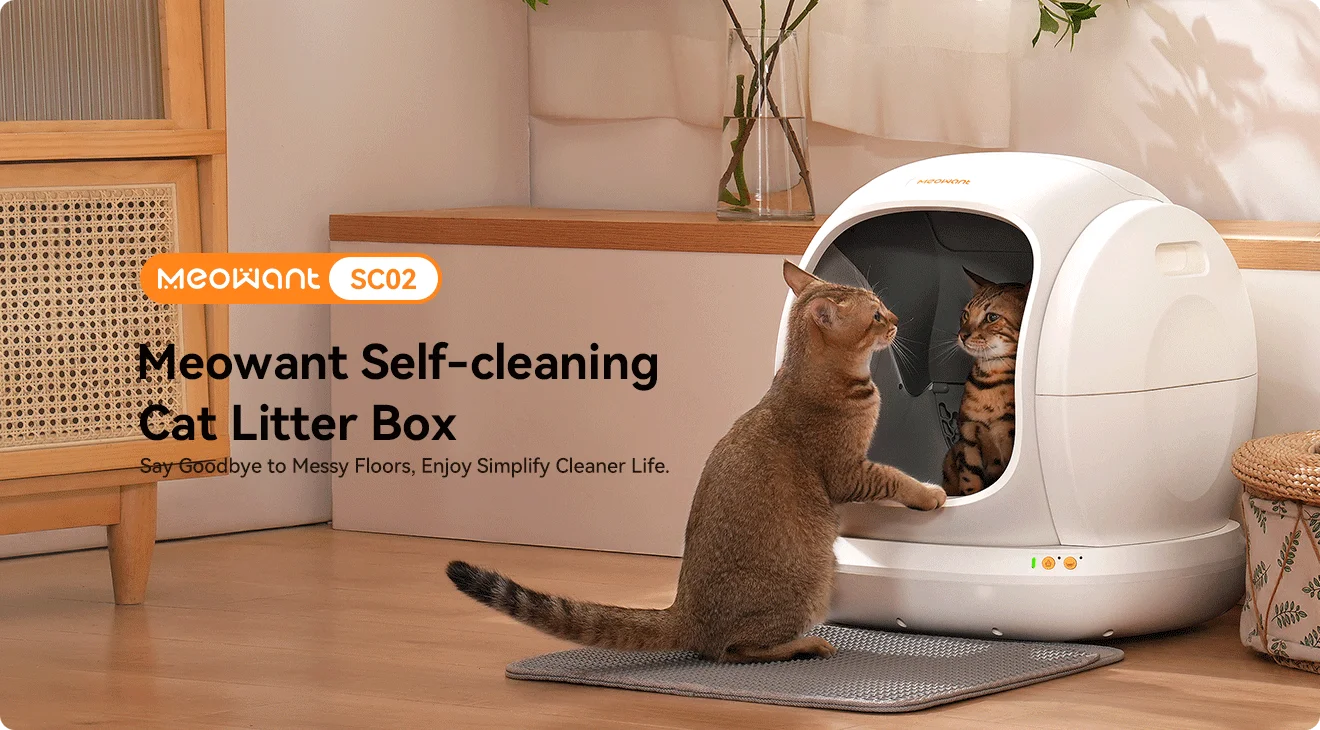Copyright researchsnipers

Managing a litter box for large cats can be challenging, especially when noise and odor become persistent problems in your home. Traditional litter boxes require constant attention, and the cleaning process often disrupts both you and your feline companion. For cat owners seeking peace of mind and a fresher living environment, finding the right solution becomes essential. Modern automatic litter boxes have revolutionized pet care by combining quiet operation with efficient self-cleaning technology. These innovative systems are specifically designed to accommodate larger cats while maintaining a serene household atmosphere. They eliminate the daily chore of scooping, reduce unpleasant odors, and operate so quietly that neither you nor your cat will be disturbed. Whether you’re a busy professional, have multiple cats, or simply want to enhance your pet care routine, an automatic litter box offers the perfect balance of convenience and performance that transforms the way you manage your cat’s hygiene needs. Introduction to Automatic Litter Boxes Automatic litter boxes represent a significant leap forward in pet care technology, designed to simplify the lives of cat owners while ensuring optimal hygiene for their pets. These intelligent systems use sensors and mechanical components to detect when your cat has used the box, then automatically rake, sift, or rotate the litter to separate waste from clean material. The collected waste is deposited into a sealed compartment or disposable receptacle, effectively containing odors and reducing bacterial growth. The primary advantage of these automated systems lies in their ability to maintain a consistently clean environment without daily human intervention. Unlike traditional boxes that accumulate waste throughout the day, automatic versions clean within minutes of each use, ensuring your cat always has access to fresh litter. This is particularly beneficial for households with multiple cats or owners who work long hours. Additionally, these systems significantly reduce your exposure to litter dust and waste handling, promoting better hygiene for the entire household. The convenience factor cannot be overstated—what once required daily scooping now demands only weekly waste disposal and occasional litter refills, freeing up valuable time while providing superior cleanliness for your feline companion. The Importance of a Self-Cleaning Litter Box Self-cleaning litter boxes have become essential for modern cat owners who want to maintain a healthy home environment without sacrificing their time or comfort. The fundamental importance lies in consistent hygiene—manual scooping often gets delayed due to busy schedules, allowing waste to accumulate and bacteria to multiply. This creates health risks for both cats and humans, as ammonia from urine builds up and pathogens spread. A self-cleaning system addresses this by removing waste promptly after each use, typically within five to twenty minutes, ensuring that your cat never has to step on soiled litter. Beyond hygiene, these systems provide significant psychological benefits for cats. Felines are naturally fastidious creatures who may avoid dirty litter boxes, leading to inappropriate elimination behaviors around your home. By maintaining pristine conditions automatically, self-cleaning boxes encourage proper litter box usage and reduce stress for your pet. For owners, the mental relief is equally valuable—no more guilt about forgetting to scoop or rushing home to clean the box. The time savings add up considerably, transforming a daily fifteen-minute chore into a simple weekly maintenance routine. This is particularly crucial for elderly owners, those with mobility issues, or pregnant women who should avoid handling cat waste due to toxoplasmosis risks. The investment in a self-cleaning system ultimately pays dividends in health protection, time management, and overall quality of life for everyone in the household. Large Cat Litter Box Options When selecting a litter box for large cats, size becomes the most critical factor—your feline needs enough room to turn around comfortably, dig, and position themselves without feeling cramped. Standard boxes typically measure around 18 inches long, but large cats weighing over 15 pounds require boxes that are at least 22-24 inches in length and width. The general rule is that your litter box should be one and a half times the length of your cat from nose to the base of their tail, ensuring adequate space for natural behaviors. Automatic litter boxes designed for larger breeds typically feature spacious chambers with high walls to prevent litter scatter and accommodate cats who prefer to stand while eliminating. Top-entry designs work well for agile large cats, as they provide privacy and contain mess effectively, though they may not suit senior or arthritic felines. Side-entry automatic models offer easier access while maintaining generous interior dimensions. The entrance opening is equally important—it should be wide enough for your cat to enter without squeezing, typically at least 10-12 inches in diameter for larger breeds like Maine Coons or Ragdolls. Weight capacity also matters, as sensors in automatic boxes must reliably detect heavier cats, so verify that any system you consider can accommodate cats up to 20-25 pounds. Some advanced models feature adjustable sensor sensitivity specifically calibrated for large breeds, preventing missed cleaning cycles. Additionally, consider the litter depth capacity—larger cats produce more waste, so boxes that hold 15-20 pounds of litter provide better odor control and require less frequent refilling than those with shallow reservoirs designed for smaller cats. Advanced Odor Control Features Quiet Operation The noise level of an automatic litter box directly impacts your household’s comfort and your cat’s willingness to use it. Many cats are naturally skittish around loud mechanical sounds, and a noisy cleaning cycle can create anxiety that leads to litter box avoidance. Modern quiet automatic litter boxes utilize brushless motors and precision-engineered gears that operate at sound levels below 40 decibels—comparable to a whisper or quiet library. This whisper-quiet performance means the cleaning cycle can run at any hour without disturbing sleeping family members or startling your cat during nighttime use. The engineering behind quiet operation involves rubber dampeners that absorb vibration, smooth rotation mechanisms that eliminate grinding sounds, and gradual acceleration that prevents sudden jarring movements. Some premium models feature sound-insulated waste compartments and soft-close lids that prevent clattering. For multi-cat households or apartments with thin walls, quiet operation becomes non-negotiable. Your cat will feel more secure approaching a box that doesn’t suddenly roar to life, and you’ll appreciate the peaceful environment, especially if the box is located near living spaces or bedrooms where noise would otherwise be disruptive. Efficient Cleaning Process An efficient cleaning process distinguishes superior automatic litter boxes from mediocre ones, directly impacting odor control and hygiene maintenance. The best systems employ multiple waste separation techniques—rotating globes that sift clumps through precisely sized openings, rake mechanisms with flexible tines that adapt to different litter types, or conveyor systems that transport waste to sealed containers. The cleaning cycle timing matters significantly; sensors should trigger the process quickly enough to prevent odor spread but allow sufficient time for clumping litter to solidify properly, typically three to seven minutes after your cat exits. Thorough waste removal depends on complete coverage of the litter surface. Systems with multi-pass cleaning cycles or counter-rotating mechanisms ensure no clumps are missed, even in corners where waste often hides. The waste receptacle design also contributes to efficiency—sealed drawers with carbon filters trap odors effectively, while disposable liner compatibility simplifies waste disposal without touching contaminated surfaces. Advanced models include waste level indicators that alert you before the container reaches capacity, preventing overflow situations. The litter conservation aspect of efficient cleaning cannot be overlooked; precise sifting mechanisms separate only waste while returning clean litter to the box, reducing the amount of fresh litter you need to add and lowering long-term operating costs while maintaining optimal cleanliness standards. Choosing the Right Automatic Litter Box Selecting the ideal automatic litter box requires careful evaluation of your specific household needs, cat characteristics, and lifestyle factors. Start by assessing your cat’s size and weight—measure from nose to tail base and weigh them to ensure the box you choose can accommodate their dimensions and trigger sensors reliably. For large breeds, prioritize models with interior dimensions of at least 24 inches and weight capacities exceeding 20 pounds. Next, consider your living space constraints. Measure the intended location carefully, accounting for the box’s footprint plus clearance space for your cat to enter and exit comfortably. Apartment dwellers should prioritize compact designs with vertical orientation, while house owners might opt for larger, more spacious units. Your household composition significantly influences the right choice. Multi-cat homes require boxes with faster cleaning cycles, larger waste compartments, and higher durability ratings to handle frequent use. Evaluate the litter type compatibility—some systems work exclusively with clumping clay, while others accommodate crystal, natural, or lightweight varieties. This affects both ongoing costs and environmental impact. Power requirements matter too; most automatic boxes need continuous electrical access, though some offer battery backup for power outages. Consider your maintenance preferences—models with disposable waste drawer liners offer convenience but increase recurring costs, while those with washable receptacles require more hands-on cleaning but cost less long-term. Budget should encompass both initial investment and operational expenses including replacement filters, waste receptacles, and compatible litter. Read verified user reviews focusing on reliability, customer service responsiveness, and longevity—a box that fails after six months wastes money regardless of its initial price. Brands like Meowant have gained recognition among cat owners for designing systems that balance large cat accommodation with quiet operation. Finally, check the warranty coverage and return policy, as your cat’s acceptance cannot be guaranteed until they actually use the device in your home environment. Advanced Odor Control Features Advanced odor control technology separates premium automatic litter boxes from basic models, creating a genuinely fresh-smelling home environment. The most effective systems employ multi-layered approaches that address odors at their source rather than simply masking them. Sealed waste compartments form the first line of defense, physically isolating soiled material from your living space immediately after the cleaning cycle completes. These airtight chambers prevent ammonia vapors and bacterial odors from escaping into the air, containing smells that would otherwise permeate your home within hours. Carbon filtration represents the second critical component—activated carbon filters absorb odor molecules chemically, neutralizing them before they can spread. High-quality boxes feature replaceable filters positioned strategically in waste drawers and ventilation areas, continuously scrubbing the air that passes through the system. Some advanced models incorporate antimicrobial coatings on interior surfaces that inhibit bacterial growth, addressing odor at its biological origin. These coatings prevent the sticky residue buildup that harbors smell-producing bacteria in traditional boxes. Additionally, smart ventilation systems in premium units create negative pressure within waste compartments, ensuring any air movement draws odors inward rather than releasing them into your home. The combination of physical containment, chemical absorption, and biological prevention creates a comprehensive odor management system that keeps your home smelling fresh even with multiple large cats, eliminating the telltale litter box smell that often greets visitors in homes with traditional boxes. Maintenance Tips for Automatic Litter Boxes Regular maintenance ensures your automatic litter box continues operating efficiently and extends its lifespan significantly. Start by establishing a weekly routine to empty the waste drawer, even if it hasn’t reached full capacity—this prevents odor buildup and keeps the system running smoothly. When emptying, inspect the drawer for any cracks or damage that might compromise the seal. Replace carbon filters according to the manufacturer’s schedule, typically every month, as saturated filters lose their odor-absorbing effectiveness. Check the litter level daily and maintain it at the recommended depth, usually three to four inches, since insufficient litter prevents proper clumping and can cause sensors to malfunction. Deep cleaning should occur monthly—unplug the unit and remove all litter, then wash interior surfaces with pet-safe enzymatic cleaner to break down residue that harbors bacteria. Avoid harsh chemicals that might leave residues harmful to your cat or damage plastic components. Inspect the rake or rotating mechanism for trapped debris and clean thoroughly, as hair and litter particles can impede movement. Wipe sensors with a soft, slightly damp cloth to ensure accurate detection. Check all moving parts for wear and lubricate according to manufacturer instructions. Finally, test the unit empty before refilling to confirm proper operation, and keep the area around the box clear to prevent litter tracking and ensure adequate ventilation for optimal odor control performance. The Future of Cat Care Automatic litter boxes have transformed cat care by delivering quiet, efficient solutions that benefit both pets and owners. These innovative systems eliminate the daily burden of manual scooping while maintaining superior hygiene through prompt waste removal and advanced odor control technology. For large cat owners specifically, choosing a spacious model with reliable sensors and whisper-quiet operation ensures your feline companion feels comfortable while keeping your home fresh and peaceful. The investment in a quality automatic litter box pays dividends through time savings, improved household cleanliness, and reduced stress for everyone involved. By selecting a system that matches your cat’s size, your living space, and your maintenance preferences, you create an optimal environment that promotes healthy litter box habits. With proper care and regular maintenance, your automatic litter box will provide years of reliable service, making it an essential addition to any modern cat owner’s home. The combination of convenience, hygiene, and tranquility makes these systems the perfect solution for those seeking a better way to manage their cat’s needs.



